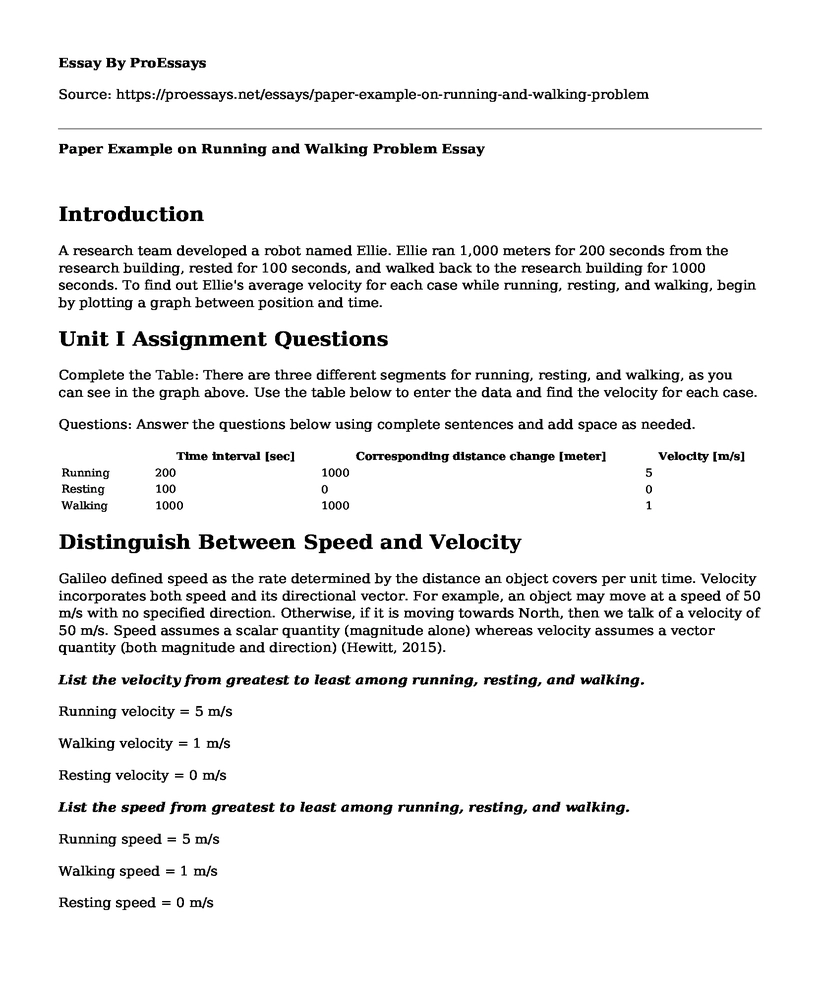Introduction
A research team developed a robot named Ellie. Ellie ran 1,000 meters for 200 seconds from the research building, rested for 100 seconds, and walked back to the research building for 1000 seconds. To find out Ellie's average velocity for each case while running, resting, and walking, begin by plotting a graph between position and time.
Unit I Assignment Questions
Complete the Table: There are three different segments for running, resting, and walking, as you can see in the graph above. Use the table below to enter the data and find the velocity for each case.
Questions: Answer the questions below using complete sentences and add space as needed.
| Time interval [sec] | Corresponding distance change [meter] | Velocity [m/s] | |
| Running | 200 | 1000 | 5 |
| Resting | 100 | 0 | 0 |
| Walking | 1000 | 1000 | 1 |
Distinguish Between Speed and Velocity
Galileo defined speed as the rate determined by the distance an object covers per unit time. Velocity incorporates both speed and its directional vector. For example, an object may move at a speed of 50 m/s with no specified direction. Otherwise, if it is moving towards North, then we talk of a velocity of 50 m/s. Speed assumes a scalar quantity (magnitude alone) whereas velocity assumes a vector quantity (both magnitude and direction) (Hewitt, 2015).
List the velocity from greatest to least among running, resting, and walking.
Running velocity = 5 m/s
Walking velocity = 1 m/s
Resting velocity = 0 m/s
List the speed from greatest to least among running, resting, and walking.
Running speed = 5 m/s
Walking speed = 1 m/s
Resting speed = 0 m/s
If the slope in the plot of distance and time is steeper, do you think the speed of the motion is increasing or decreasing? Why do you think so?
I think that in a straight line graph of distance and time, the speed of the motion is constant regardless of the steepness of the slope. In comparing two different slopes in a curve, the steeper the slope, the higher the speed. Steeper slopes mean that an object will take less time to reach its destination than in the motions depicted by less steep slopes. A speed of 300 m/s will be represented by steeper distance-time slope than a motion at a speed of 500 m/s.
If the slope in the position versus time graph is a curved line, what can you tell about the motion?
The curve of the position and time above shows that the curve becomes steeper with time. Steeper slopes mean quicker motion and the less steep slopes mean slower motion. Therefore, the motion of the object movement represented by the curve above shows that the object is accelerating (Hewitt, 2015). An accelerating object will at one time take, for instance, 100 seconds in covering 100 meters, and at another time take 50 seconds in covering the same distance. The curve represents this same concept.
Reference
Hewitt, P. G. (2015). Conceptual physics (12th ed.). Boston, MA: Pearson.
Cite this page
Paper Example on Running and Walking Problem. (2022, Jun 10). Retrieved from https://proessays.net/essays/paper-example-on-running-and-walking-problem
If you are the original author of this essay and no longer wish to have it published on the ProEssays website, please click below to request its removal:
- Digital Millennium Copyright Act Analysis: Essay Sample
- Paper Example on Innovation and Competitive Advantage: Changing Environments
- Questions and Answers Essay on Apple's Problems
- Research Paper on Technology that has Impacted World Culture: iPhone
- Paper Example on Solar Power: Cost Reduction for Grid Parity
- Natural Power, Ethanol Fueling Nations: Responder Strategies - Research Paper
- CIOs: Be Familiar With 4 Unethical AI Issues - Essay Sample







